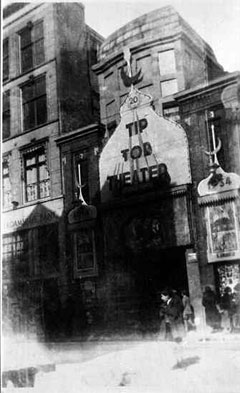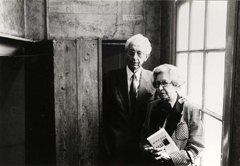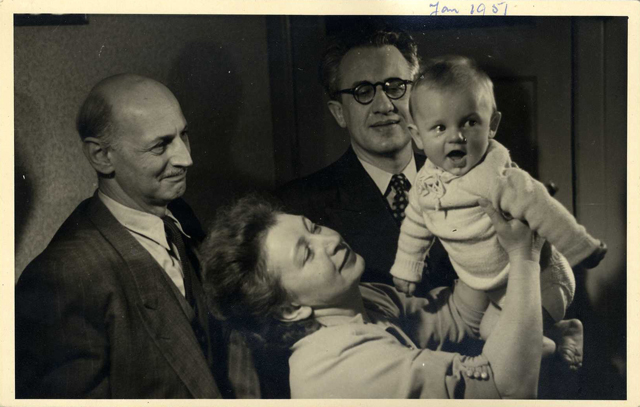
Jan and Miep Gies on their wedding day on July 16, 1941Besides her office job, Miep Gies had a busy social life. She enjoyed social events and, as so many of her peers, attended dancing lessons. During the 'free style dancing' organized on Friday and Saturday evenings, she and her friends would practice what they had learnt in the preceding week. ‘I was such a peppy dancer and loved dancing so much that I was never left sitting. Young men always seemed to be holding their large hands out to me, to dance with me and to escort me home afterward.’
Although she counted several agreeable young men among her friends, there was one that really caught her eye. He was '(...) a very tall, well-dressed, highly appealing Dutchman a few years older than I. His name was Jan Gies. (...) I found Jan most attractive. His thick fair hair gleamed. His eyes were warm and full of life.'
Miep and Jan had met each other while working at the textile company. She worked there as a typist and he was an accountant. They became friends and stayed in touch, even after she was laid off and started working at Otto Frank's Opekta company, and he became a social worker with the Amsterdam Social Service. They both lived in the Amsterdam district called Rivierenbuurt, except that he had his own room with people living in Rijnstraat, while Miep still lived with her foster parents and shared a room with her sister Catherina.
The Tip Top cinema in Jodenbreestraat, ca. 1935Jan and Miep's friendship evolved into a love affair. They started seeing each other increasingly frequently and discovered that they both had a passion for music by Mozart, with the same favorite flute and harp concerto. Every Saturday evening they went to the Tip Top cinema in Jodenbreestraat, and on sunny days they went on bicycle outings. ‘One bicycle, that is. Jan would pedal, and I’d sit sideways behind him, my legs raised above the ground, my skirt flapping (away in the wind, my back pressed outward, balancing me, my arms loosely holding Jan by his waist. All of Amsterdam would mount its trusty black bicycle on any warm, sunny day, just like us. Whole families could fit on a bicycle or two.' They also enjoyed strolling through the flea market in the old Jewish neighborhood by the Portuguese synagogue in Muiderstraat.
At the time that Miep worked at the Singel address and Jan at the municipal Social Service, they often took a walk together during the lunch break. That is how Jan got to know Otto Frank, Miep's employer. Miep thought that they looked alike in terms of build, both being tall and slender, but also in terms of character. They had the same ironic sense of humor and were both principled men that wasted no words. The first time that Otto Frank invited Miep for dinner at his home, he asked her to bring Jan along as well. The dinner was not a once-only affair, and during the many visits that followed, Miep and Jan became increasingly well-acquainted with the whole Frank family, including the two young daughters, Margot and Anne. During these evenings, the terrifying events taking place around the world were also discussed at length over coffee and cake, sometimes in the company of other friends and acquaintances of Edith and Otto Frank. ‘As soon as Margot and Anne were called to the dinner table, we curtailed our discussion of thes dreadful things. (We lightened) up our voices and spoke only about cheerful and pleasant subjects. Subjects suitable for innocent and impressionable children’s ears.'
Miep and Jan were eager to become engaged, but didn't have any savings to pay for a wedding or to buy furniture for their own home. Although they very much wanted to start living a shared life, as so many other couples at that time their dating phase went on and on. When Miep turned thirty and Jan was almost 34, they decided to take the gamble in early 1939, and started seeking a house for themselves. As soon as they found something they would also be able to get married. Yet it seemed impossible to find a dwelling. All rooms, attics and basements were already rented out, often to people that had fled Hitler's regime. Amsterdam was filled to bursting. Hitler's Nazi Germany had already swallowed up Austria in 1938, and on September 1, 1939, Germany invaded Poland. And eight months later, it was the Netherlands' turn.
Although Miep had been living in the Netherlands since December of 1920, she had always kept her Austrian nationality. Since Austria no longer existed after its annexation by Nazi Germany in 1938, Miep tried to obtain the Dutch nationality in 1939 through a letter to Queen Wilhemina. Below is the carbon copy of that letter to the Queen.

Carbon copy of a letter that Miep Gies wrote to Queen Wilhemina in 1939, requesting the Dutch nationality.
Despite the considerable housing shortage, Miep and Jan had a turn of luck shortly after the German invasion, when Otto Frank pointed out an advertisement offering rooms to rent in their own neighborhood, at Hunzestraat 25. The next day Mr. Frank accompanied Miep to see the rooms, before going to the office. The landlady was a Jewish Mrs. Stoppelman, who wanted to rent out two rooms of her house because she had recently and quite unexpectedly turned single. Her husband had, by some sudden chance occurrence, ended up on a ship sailing from Ijmuiden to England. He had arrived there safe and sound, but Mrs. Stoppelman had no idea if she would ever see him again. She was relieved to hear that Miep was eager to rent the rooms. Miep initially thought it better not to tell her that she and Jan were not yet married, but once they got to know each other better, they decided it was safe to confess to this. They simply lacked the money to get married any time soon. 
Miep and Jan Gies, fall of 1985, in AmsterdamWhile the Germans surged through most of Europe like a tidal wave, life in Amsterdam seemed to continue much as before. It was a beautiful summer and Miep and Jan were happy. But as autumn approached, the directives targeting Jews gradually became more in number and graver in scope. ‘We felt deep anxiety for our Jewish friends. I was eaten by a feeling of terrible regret. How had we been so naive as to think that our neutrality would be respected by an immoral man like Adolf Hitler? If only our Jewish friends had gone to America or Canada! Henk and I felt special pangs of regret for the Franks, with their two young children. Mrs. Frank, in fact, had two brothers who had gone to America.'
All of a sudden, Miep was summoned to the German consulate. After handing over her Austrian passport, she was asked whether it was true that she had refused to join a Nazi girls' association. When she confirmed that this was so, the German entered a big black X next to the expiry date and returned her passport with the words: “Your passport has been invalidated. You must return to Vienna within three months. Unless you marry a Dutch man.”
Of course Jan and Miep wanted to marry, but to do so she needed to obtain her birth certificate from Vienna. It seemed impossible to arrange for this within three months. Even in normal circumstances, without any war going on, this would already take about one year. Nevertheless, Miep decided to do all she could, and she immediately sent a letter to her uncle in Vienna, with the highly urgent request to send her the birth certificate as quickly as possible. Although his attempts initially failed, Miep's highly persevering uncle finally got lucky. A friendly civil servant at the Viennese city hall had fond memories of the Netherlands, and she provided Uncle Anton with the birth certificate of Hermine Santruschitz. When Miep received the certificate in Amsterdam, she and Jan immediately made an appointment at the city hall to get married. The wedding date was set for July 16, 1941.
It was a marvelous summer day on which Jan and Miep, along with two other couples (which was the most affordable option), stood before the municipal official, anxious that the official might refuse to conclude the wedding because of the black X in Miep's passport, forcing her to return to Vienna instead. But Miep was once again fortunate, for after carefully studying the passport, the official indicated that everything was in order. Miep not only married the love of her life Jan, but also officially became a Dutch national. 
Jan and Miep Gies in the Secret Annex by the bookcase that closed off the hiding space, ca. 1988Nine months later, Miep once again solemnly said 'yes', this time when Otto Frank told her of his plans to go into hiding, along with the Van Pels family, and he asked her whether she was willing to take on the responsibility of caring for seven hiders. "Of course", is what she said. Jan, too, pledged his unconditional help.
Elsewhere on this website you can read more about the time that Miep and Jan Gies were two of the helpers for the people hiding in the Secret Annex. In addition to helping those hiding in the Secret Annex, Miep and Jan had also taken a hider into their own home on Hunzestraat, in the spring of 1943. It was a Dutch student who had refused to sign the German oath of allegiance, imposed on all students. Jan was furthermore closely involved with an underground network through his work for the municipal Social Service. The betrayal that led to the arrest of the eight people in hiding on Prinsengracht, and their subsequent deportation to various concentration camps, did not lead to the arrest of Miep and Jan Gies.
When Otto Frank arrived on Miep and Jan's doorstep in the summer of 1945, he would continue to live with them until 1953. His wife Edith and daughters Margot and Anne had perished in the camps. Miep was able to entrust Anne's diaries to Otto Frank's care, and he saw to it that they were published in 1947. Jan and Miep's son Paul was born on 30 July 1950. They continued to live in Amsterdam until Jan passed away in 1993. After that Miep moved to the same town in North Holland where her son Paul lives.

Otto Frank, Miep and Jan Gies with son Paul, January 1951, AmsterdamAll quotes in this chapter are taken from the book Anne Frank Remembered. The Story of the Woman Who Helped to Hide the Frank Family. By Miep Gies with Alison Gold. Simon and Schuster, New York 1987.
A new edition of the book is expected for early 2009.


